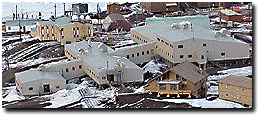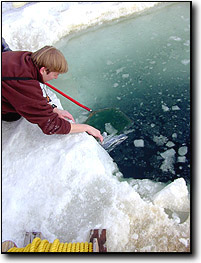 |
|
|
 |
||
|
||||||||||||||||||||||||||||||||||||||||||||||||||||||||||||||||||||
|
This document has been archived.
This material is available primarily for archival purposes. Telephone numbers or other contact information may be out of date; please see current contact information at media contacts.
Marine Biology Course Uses Antarctica as its Classroom
Commuting to class on the world's southernmost continent isn't easy. But the campus, located a few hundred miles from the South Pole and on the edge of a unique marine ecosystem, offers unparalleled opportunities to explore biology's frigid frontiers. The National Science Foundation (NSF), which manages the U.S. Antarctic Program (USAP), annually opens its facilities at McMurdo Station on Ross Island to host an unusual graduate-level course in marine biology. McMurdo is the largest U.S. scientific station in Antarctica and is the site of the Albert P. Crary Science and Engineering Center, a state-of-the-art laboratory complex, which the students use as their classroom. This year, 24 students -- the majority from the United States but also others from the United Kingdom, Spain, Germany, Canada, and the Netherlands -- traveled to Antarctica to study creatures unique to the Southern Ocean and their strategies for surviving at the extreme limits of life on earth. "This is one of the frontiers left in biology," noted instructor Adam Marsh, of the University of Southern California, in an opening lecture. "There are a lot of interesting questions still unanswered about how these organisms live at these margins." The brainchild of Donal Manahan, who heads the Department of Biological Sciences at the University of Southern California, and NSF's Polly Penhale, who oversees biological and medical research for the Antarctic Program, the course is designed to provide graduate students with an education that approximates the working conditions of the hundreds of scientists who travel to Antarctica every year under NSF's auspices. "The idea was to offer a field and laboratory course that would introduce students to the complexity and diversity of biological adaptations found in extreme polar environments," noted Manahan. Penhale added that the course "not only fosters international collaborations, but directly meets NSF's goal to integrate research and education." Lectures on subjects ranging from the geography of Antarctica to the safe handling of low-level radioactive materials are held in the Crary lab. Students also make presentations to their peers about their research as part of the classroom portion of the course. But in the same way that NSF-supported scientists go out into the field to conduct their Antarctic research, students also use snowmobiles to travel to holes drilled in the sea ice to conduct sampling. They also are helicoptered to remote sites to sample macroalgae and work with a scuba diver to collect marine animals. Although seemingly remote from the rest of the world and strikingly different, the course emphasizes that Antarctica and its surrounding waters play a major role in global climate. The Southern Ocean, which forms a barrier around the Antarctica, for example, helps regulate global temperatures as its supercooled water drive global ocean currents. "The Southern Ocean is perhaps the world's largest marine ecosystem," noted Wade Jeffrey, of the University of West Florida. Because of Antarctica's effects on global currents, he added, "what goes on in the Antarctic circulation does indeed effect what goes on in the rest of the world." After a month of study in Antarctica, students will return home this month. Note to Editors: For B-roll and 300 dpi still images of students in Antarctica, contact the media officer listed above. Attachment: List of students
Antarctic Biology Course Students (1999-2000 Season)
|
||||||||||||||||||||||||||||||||||||||||||||||||||||||||||||||||||||
|
|
| |



